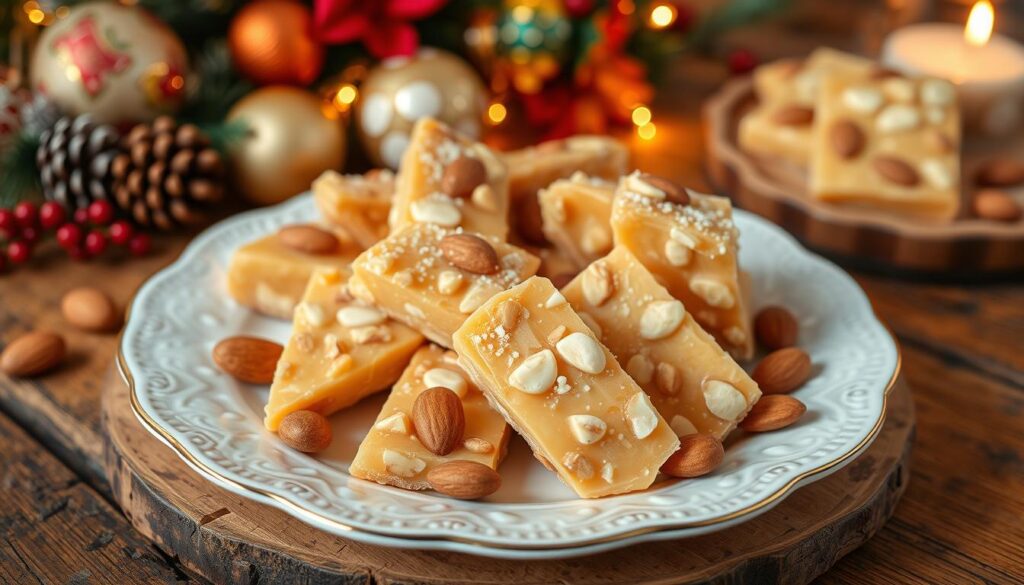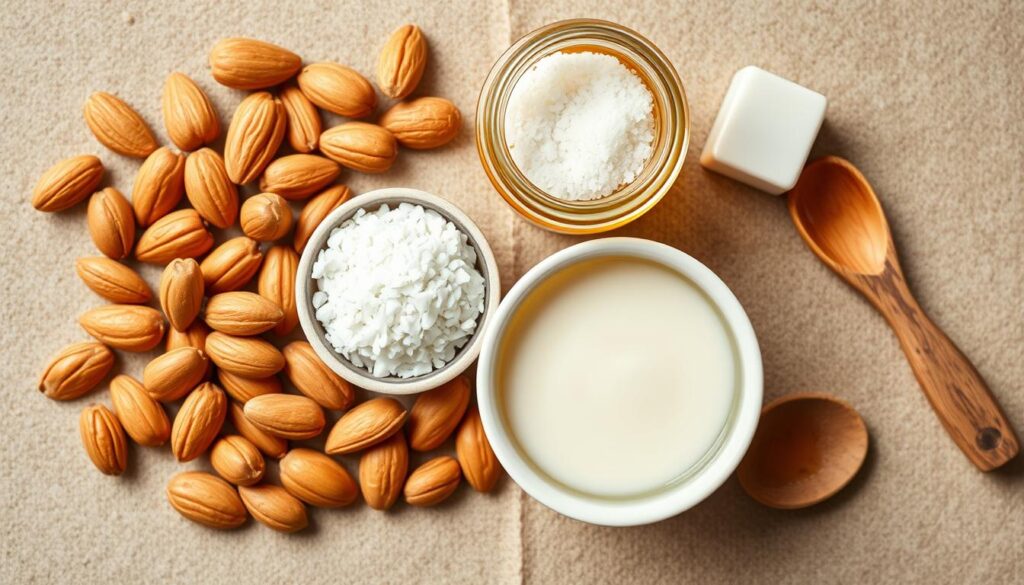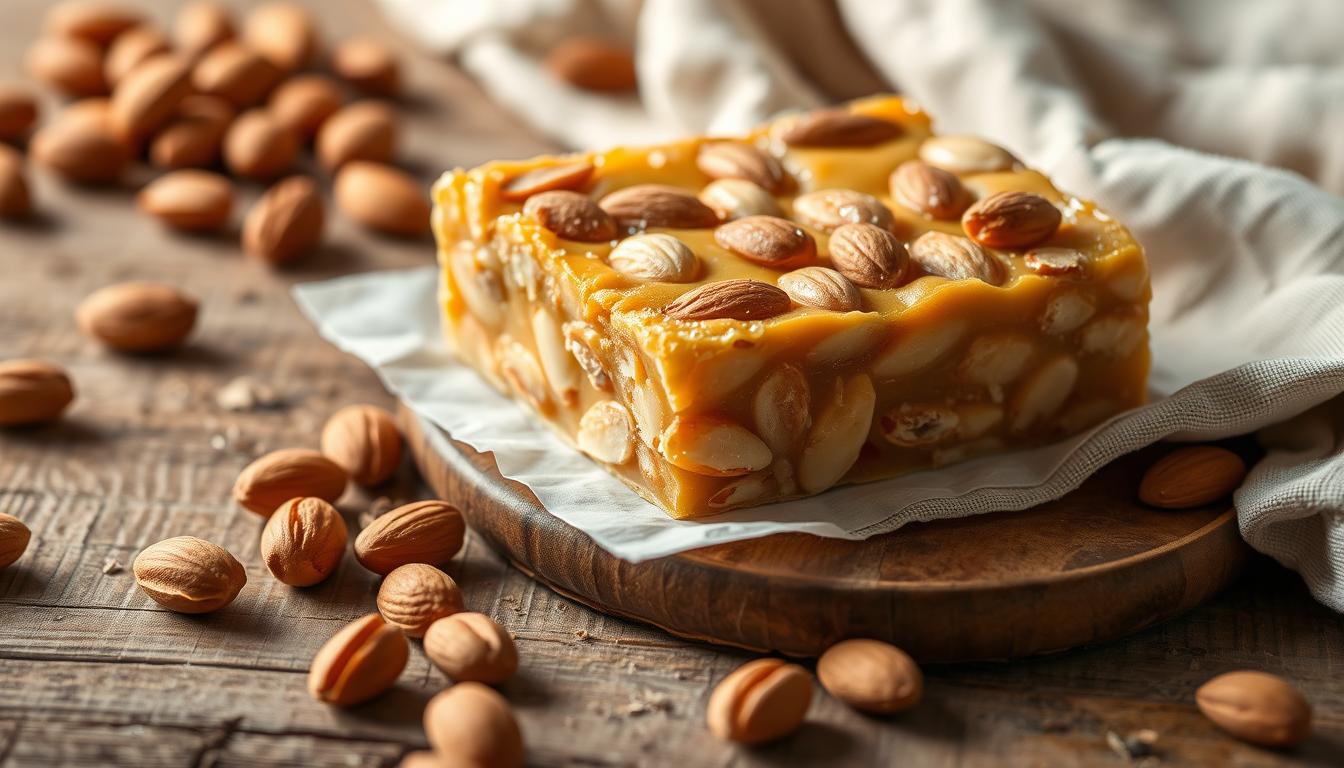As winter’s cool air arrives and the holiday season nears, the scent of wafts through the air. It invites you to try the classic Spanish treat, Turrón de Alicante. This hard, crunchy nougat, filled with Marcona almonds, has been a favorite in Spanish homes for years. It captures the heart of Spain’s rich food traditions.
Turrón de Alicante comes from Spain’s Alicante region. It’s a true holiday classic. Its unique texture comes from a mix of sweet honey and buttery, toasted Marcona almonds. Each bite takes you to a winter wonderland, where the flavors of this Spanish blend with the holiday spirit.
Key Takeaways
- Turrón de Alicante is a traditional Spanish made with high-quality Marcona almonds and rosemary honey.
- The confection is known for its hard, crunchy texture and is typically enjoyed during the Christmas season.
- Turrón de Alicante is available in various sizes, with common weights around 420g and 620g.
- The unique flavor profile of Turrón de Alicante makes it a cherished holiday treat and a beloved part of Spanish culinary heritage.
- This serves as an excellent complement to Spanish wines and cheeses, enhancing the overall culinary experience.
Understanding Turrón de Alicante: A Spanish Holiday Tradition
Turrón de Alicante is a beloved valencian sweet deeply rooted in Spanish culture, especially in Alicante. This traditional Spanish treat has been a holiday favorite for centuries.
Origins and Cultural Significance
The history of turrón de Alicante goes back to the 15th century. It became a key part of Spain’s culture and food heritage. Made with honey, sugar, egg whites, and Marcona almonds, it stands out from softer turrón de Jijona.
Regional Variations
- Turrón de Yema Tostada, a variant that includes egg yolks and caramelized sugar
- Turrón de Chocolate con Almendras, which features rich chunks of chocolate mixed with crispy almonds
- “Turrones artesanos,” artisanal turrón with unique ingredients like candied fruits or liquors such as rum or whiskey
Traditional Consumption Patterns
In Spain, turrón de Alicante is a holiday staple. It’s shared with family and friends. Served in small pieces, its hard texture pairs well with honey and almonds. Turrón is also enjoyed throughout the year in Spanish stores and bakeries.
| Variety | Almond Content |
|---|---|
| Supreme Grade | More than 60% almonds |
| Extra Grade | 50% to 60% almonds |
| Standard Quality | 40% to 50% almonds |
| Popular Quality | 30% to 40% almonds |
| Not Considered | Below 30% almonds |

Essential Ingredients for Authentic Turrón de Alicante
Turrón de Alicante is a beloved Spanish holiday treat. It’s filled with rich cultural heritage. At its core are a few key ingredients that give it its unique taste and feel.
The main parts for making real Turrón de Alicante include:
- High-quality Marcona almonds – These special Spanish almonds are loved for their sweet, buttery taste and soft crunch. They’re key to the traditional turrón taste.
- Honey – Fragrant rosemary honey is often used. It adds a subtle floral taste that goes well with the nutty flavors.
- Sugar – Granulated sugar is mixed with honey to make the confection’s chewy, caramelized texture.
- Egg whites – Lightly whipped egg whites help hold the ingredients together. They add a light, airy feel to the confection.
- Lemon zest and cinnamon – These optional ingredients can be added to boost the flavor.
Even though some recipes might add extra nuts or spices, the main ingredients are Marcona almonds, honey, sugar, and egg whites. These are the true signs of authentic artisanal confection and almond confection Turrón de Alicante.

“The utilize of Marcona almonds is vital for accomplishing the conventional flavor and surface of Turrón de Alicante.”
The Distinctive Characteristics of Marcona Almonds
Marcona almonds are key to the authentic spanish nougat called Turrón de Alicante. These almonds, from Spain, have qualities that make them different from California almonds.
Comparison with California Almonds
Marcona almonds are rounder, larger, and softer than California almonds. They have more fat, which makes them sweeter and buttery. This is why Turrón de Alicante tastes so unique.
Flavor Profile and Texture
Marcona almonds have a creamy, sweet flavor. Their soft texture makes Turrón de Alicante a luxurious treat. It’s a perfect mix of chewy and soft.
Nutritional Benefits
Marcona almonds are not just tasty; they’re also nutritious. They’re full of healthy fats, protein, and vitamins. This makes Turrón de Alicante a healthier treat option.

| Nutrient | Marcona Almonds | California Almonds |
|---|---|---|
| Fat (g) | 54.6 | 49.9 |
| Protein (g) | 21.4 | 21.2 |
| Fiber (g) | 8.4 | 12.2 |
| Magnesium (mg) | 270 | 268 |
| Vitamin E (mg) | 32.4 | 25.6 |
Step-by-Step Preparation Techniques
Making the beloved artisanal confection, Turrón de Alicante, a traditional spanish treat, is a cherished tradition. It shows the hard work of Spanish confectioners. The key to this tasty nougat is a mix of roasted Marcona almonds, golden honey, and crisp sugar.
- Start by roasting 250g (2 cups) of whole Marcona almonds until they smell fragrant and are lightly browned. This step brings out their normal oils and flavor.
- Grind the almonds into a fine meal. This makes sure the texture is smooth and even, blending well with the nougat.
- In a saucepan, mix 150g (3/4 cup) of honey and 150g (3/4 cup) of sugar. Heat it over medium-low, stirring constantly, until it hits 140°C (285°F) on a candy thermometer.
- Pour the hot honey-sugar syrup over the ground almonds. Mix until it forms a thick, cohesive paste.
- If you want, add 2 egg whites that have been whipped stiff. This makes the nougat light and airy.
- Press the mixture into a mold or pan lined with wafer paper. This ensures it’s evenly spread.
- Let the turrón rest for up to 14 days. This allows it to set and dry, giving it its firm yet soft texture.
For a quicker method, cook the turrón over low heat, stirring constantly, until it reaches the right consistency. This skips the long resting time. But, the true beauty of Turrón de Alicante is in the careful steps and respect for Spanish confectionery traditions.
“The craftsmanship of creating turrón de Alicante is a confirmation to the persevering culinary legacy of Spain, where each step is saturated with care and convention.”
Traditional vs Modern Production Methods of Turron
The making of Turrón de Alicante shows Spain’s deep love for food. It’s all about hand-mixing top-notch Marcona almonds, egg whites, and honey. Then, it’s dried for a long time. This keeps the flavors and textures that Spaniards love for ages.
On the other hand, making christmas candy Turrón for the masses is different. It uses the same recipe but with machines for mixing and quicker drying. This way, more Turrón can be made without losing its true taste.
Both ways aim to keep Turrón’s hard texture and almond taste. It’s up to you if you prefer the old way or the quick method. It’s about what you value more: tradition or convenience.
Texture and Appearance Guidelines
The classic spanish nougat called Turrón de Alicante has key texture and appearance traits. It should be hard and brittle, breaking cleanly when you snap it. This is what makes it special.
The look of real Turrón de Alicante is also unique. It’s white or off-white, with whole Marcona almonds spread out. The surface might have a bit of shine from the honey. When you cut into it, you’ll see the almonds mixed in with the candy.
| Texture Characteristics | Appearance Attributes |
|---|---|
| Hard, brittle consistency | White or off-white color |
| Snaps cleanly when broken | Whole Marcona almonds evenly distributed |
| – | Slight sheen on the surface |
Following these guidelines ensures you’re enjoying real, high-quality Turrón de Alicante. It keeps alive the rich traditions of this almond confection.
Storage and Preservation Methods
Turrón de Alicante is a favorite Spanish christmas candy and holiday dessert. It has a long shelf life when stored right. This makes it perfect for gifting or enjoying all holiday season.
Optimal Temperature Conditions
Keeping turrón de Alicante at the right temperature is key. It should be stored at room temperature in a cool, dry spot. This way, it stays crunchy and flavorful for longer.
Shelf Life Considerations
Turrón de Alicante can last months if stored well. Its hard texture helps it stay fresh longer. But, too much moisture can make it soft and less tasty.
To enjoy your turrón de Alicante best, eat it within a few months. Follow these storage tips to keep your holiday dessert fresh and tasty for everyone.
Serving Suggestions and Pairings
Turrón de Alicante, the classic Spanish holiday nougat, is a versatile treat. It can be enjoyed in various ways. As a holiday dessert or christmas candy, it shines as a main attraction or a delightful side dish.
Presenting turrón de Alicante in thin slices or small cubes is a traditional way. Its rich, creamy texture and delicate almond flavor pair well with sweet dessert wines or a robust Spanish coffee. For a touch of elegance, try crumbling the nougat over vanilla ice cream or adding it to a holiday cheese board with manchego, tetilla, or cabrales cheeses.
- Pair turrón de Alicante with sweet dessert wines like Sherry Amontillado or Moscatel for a decadent after-dinner delight.
- Enjoy the nougat as a standalone holiday dessert or christmas candy, savoring its satisfying texture and flavor.
- Incorporate turrón de Alicante into your holiday entertaining by crumbling it over ice cream or including it on a festive cheese board.
Whether served as a standalone treat or as part of a larger holiday spread, turrón de Alicante is sure to delight the senses. It creates lasting memories of the Spanish holiday season.
“Turrón de Alicante is a Spanish holiday tradition that brings joy and indulgence to the festive season.”
Regional Variations and Quality Classifications
Turrón de Alicante is a special type of Spanish nougat. But, different parts of the country have their own versions. Some are softer, while others are hard and crunchy.
The quality of these treats often depends on how much almonds they have. The more almonds, the better the nougat.
Protected Geographical Indication (PGI) status is important. It means the Turrón de Alicante meets certain quality standards. For example, Turrón de Agramunt is known for its hard texture and uses at least 60% almonds.
On the other hand, Turrón de Jijona is soft and smooth. It has between 50-60% almonds.
Knowing the almond content helps you choose a better turrón. More almonds mean a richer taste and texture. Whether you like the hard Turrón de Alicante or the soft Turrón de Jijona, there’s something for everyone.

